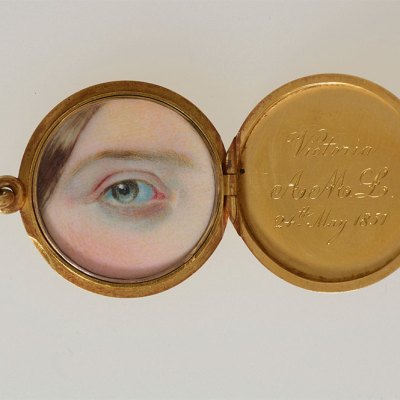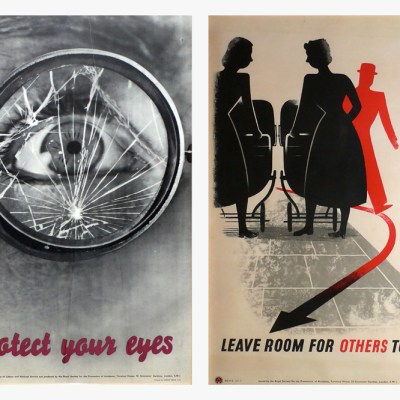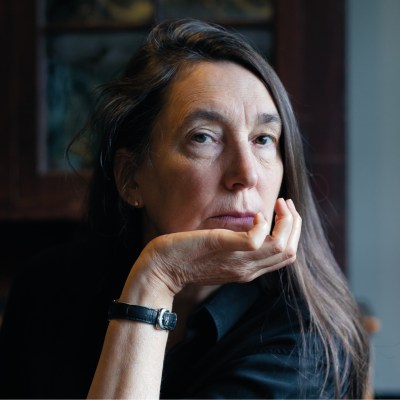‘Anne Collier: Eye’ at Lismore Castle Arts is a survey of the artist’s long-standing interest in, well, eyes – and it seems entirely intentional that the ‘eye’ of the title is a homophone for the ‘I’ of the artist. Collier’s work spans photography and found media and the earliest work in the show, Eye (Soft Contours) (2007), is a flat lay of an eye taken from a photographic manual: an artefact from when Collier used to work as a retoucher for another artist. Self-portraits also feature in the show – although blink and you might miss them. Developing Tray #3 (Grey) (2009), for instance, shows a print of Collier’s eye in close-up, positioned as the title describes. The individuating iris is anonymised in black and white, here just another tool in the darkroom.
In another self-portrait, Cut (2009), a similar print of Collier’s eye sits in a paper-cutting guillotine – its position recalling the incision of the woman/cow’s eye in Un Chien Andalou (1929). Collier is interested in how eyes – particularly when abstracted from the rest of the body and face – are often gendered; note the perfectly pruned brow in Eye (Soft Contours). Images of women crying, collected from record sleeves, magazines and comic books, abound in Collier’s work, which zooms in on often-overlooked details that fuel sexist stereotypes of leaky women. Collier treats these images as signifiers of pain and grief, even when they are cartoonishly unreal: in Woman Crying (Comic) (2020), each printed Ben Day dot is crystalline in its clarity. Woman Crying #20 and Woman Crying #21 (both 2021) feature two sides, right and left respectively, of a woman’s tearful face. The details are taken from a mayonnaise advert, but with the context removed and one side bigger than the other, the effect is like a jaunty cubist diptych – an artwork that links Picasso’s Weeping Woman (1937) with Madison Avenue’s ad men.
Woman Crying #21 (2009), Anne Collier. Courtesy the artist and The Modern Institute, Toby Webster Ltd, Glasgow, Anton Kern Gallery, New York, Galerie Neu, Berlin and Gladstone Gallery, Brussels; © the artist

For Collier, whose artistic career started in the early 2000s as the digital age was exploding, looking is an emotional act. ‘There’s a melancholy in looking […] I got interested in photography through looking at family albums and old magazines,’ Collier explains. For an artist whose work is committedly analogue, photography is a spectral medium that recalls a bygone era. The tactility of the photographic print is foregrounded in Eye #1 (2014) where a hand, possibly Collier’s own, holds a print of an eye that gazes languorously back.
Shutter (2022), one of the newest works in the show, is the most powerful evocation of a dying medium. An installation inside a darkened turret in the oldest part of Lismore Castle, it is made up of a 35mm slide-projector on a pedestal that illuminates a slideshow on the opposite wall. Each frame depicts a camera and a hand taken from a split second of a film; each frame is the same, give or take some slight movement or blur. The clunk – or click – between slides reaches a crescendo at the end of each rotation when the machine whirrs around to reload. There’s little hidden meaning here: the medium is the message. ‘We don’t know what it’s taking a picture of, or there’s nothing in the lens,’ Collier says. ‘I liked the idea that it’s a vessel for anything you wanted to project.’ The installation is an atmospheric, auratic space, where the mind’s eye can project dreams on a never-ending loop.
Filter #4 (Green) (2021), Anne Collier. Courtesy the artist and The Modern Institute, Toby Webster Ltd, Glasgow, Anton Kern Gallery, New York, Galerie Neu, Berlin and Gladstone Gallery, Brussels; © Anne Collier

In the Filter series, an image of a beautiful woman (crying, of course) from a vintage comic book is blown up repeatedly and covered with different Kodak Color Print Viewing Filters. Placed side by side on a spectrum from cyan to green, these images, although changed, cannot be further transformed. In The Photographer’s Eye (2016), an advertisement for a lens from an old photography magazine features an image of a topless woman. There the male gaze is built into the photographic apparatus itself. ‘Viewing the world through every conceivable focal length – to inspire a virtually unlimited range of creative expression,’ reads the advert. With every focal length moving closer and closer to the model’s breasts, it would seem this creative expression is, in fact, pretty limited.
Although Collier’s work is defined by flatness – the C-prints are so straight on and airless that they feel as tight as scans – the images are not lacking in depth. Collier talks about ‘layering’, meaning that her works receive the cultural knowledge that the viewer brings to them. ‘Eye’, which includes mainly large-scale works in close-up, is curated sparsely. ‘I wanted to avoid the overpackedness of a magazine, with images on top of one another,’ the artist says. There is room here for the viewer to think, to daydream and reflect. Whether they think of green-eyed monsters or windows to the soul, the meaning of these works is in the eye of the beholder.
‘Anne Collier: Eye’ is at Lismore Castle Arts, County Waterford, until 29 October.
Not in the OSM – sometimes hyphenated; what’s our style?
‘Anne Collier: Eye’ is at Lismore County Arts, County Wexford, until 29 October.



